U.S. Review
Fed Cuts Again, But Dissent Rises
- The Federal Reserve reduced the fed funds rate 25 bps this week, continuing to cite economic weakness overseas and “muted inflation pressures.”
- The higher pace of home sales and improving builder confidence should feed through to stronger construction later this year, meaning residential investment should finally contribute positively to GDP growth.
- Manufacturing production rebounded in August, but is still down over the past year.
- The surge in oil prices should have fairly limited effect on the U.S. economy, while the spike in repo rates was largely due to technical factors.
Fed Cuts Again, But Dissent Rises
The Federal Reserve reduced the fed funds rate 25 bps this week, continuing to cite economic weakness overseas and “muted inflation pressures” as justification to ease monetary policy.
The week certainly started with a bang, as oil prices surged after the weekend attack on Saudi Arabian oil facilities and a spike in overnight money market rates drove the Fed to undertake its first overnight repo operations since 2008. We would emphasize that neither is overly concerning for the U.S. economy. We estimate that even a 10% increase in WTI prices would raise year-over-year CPI inflation just 0.1-0.2 percentage points, which is relatively limited but does come at a time when importers and consumers are beginning to face a greater tariff impact. Yet the United States is now the largest oil producer in the world, meaning it is less vulnerable to external energy shocks. The jump in repo rates, meanwhile, was largely due to technical factors and the Fed’s actions are certainly not a new round of QE (see Interest Rate Watch).
The FOMC meeting produced no major surprises—the cut was widely expected—but was notable for the rising dissent among the committee. James Bullard preferred a 50 bps cut, while Esther George and Eric Rosengren wanted to keep rates steady. There were no major changes to the statement or to the forecasts for growth and inflation. On net, the dot plot and Powell’s press conference were received as slightly less dovish than expected. Seven of the 17 dots expected one more cut this year, indicating several committee members, but not a majority, favor further easing. We still expect a 25 bps cut in the fourth quarter and one more in the first quarter of 2020, but recognize that these are not set in stone, particularly as the range of views at the FOMC widens and consensus becomes harder to maintain.
With the Fed continuing to emphasize data dependence, the housing market, perhaps the most interest rate-sensitive sector of the economy, takes on greater importance as an indicator of the efficacy of monetary policy in shielding the domestic economy from weakness overseas and in manufacturing. Total housing starts jumped 12.3% to a 1.36 million-unit pace, the highest since June 2007, while existing home sales rose again in August, marking the first back-to-back increase since 2017. The roughly 130 bps decline in mortgage rates has boosted sales and firmed prices, and lower short term rates are helping homebuilders. Despite this, we suspect builders are cautious, wary of trade policy uncertainty and stock market volatility leading to a sudden pullback in demand. Still, the stronger sales pace and improving builder confidence should feed through to stronger construction later this year. After dragging on overall GDP growth for six straight quarters, residential investment is finally poised to boost growth in the third quarter and through next year.
Industrial production rebounded 0.6% in August, with a strong 0.5% gain in manufacturing output. Compared to a year ago, manufacturing production is still down, but August’s report suggests the situation is at least not worsening at the moment. Powell largely stuck to his core message this week—the situation with trade is extremely fluid and out of the Fed’s control. It will respond as the situation evolves, doing what is necessary to prolong the expansion. We expect that means two more cuts, but dissent is rising.
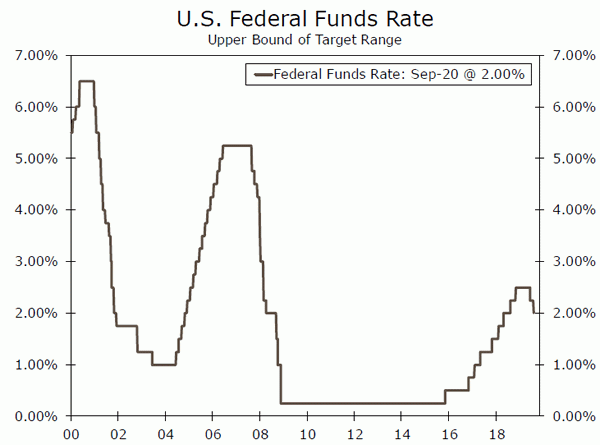
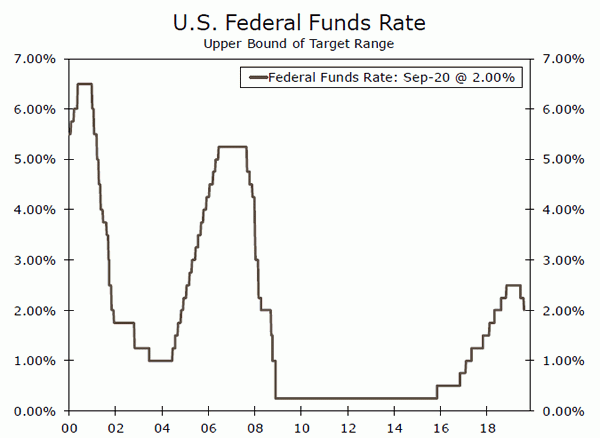
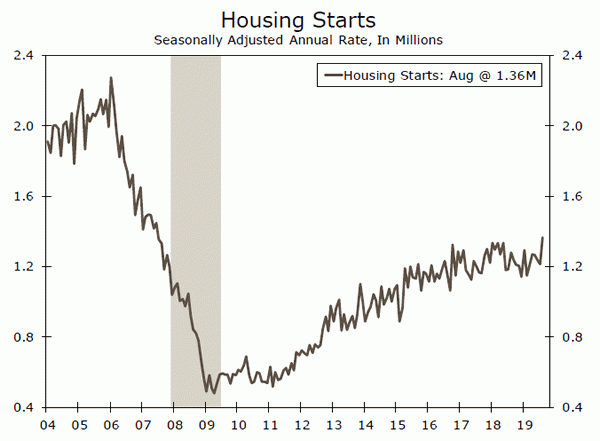
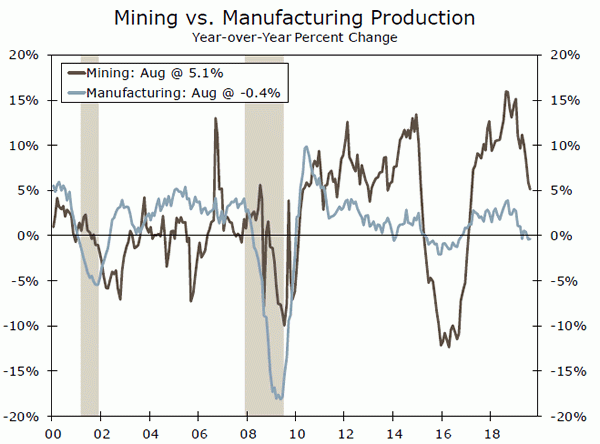
U.S. Outlook
Consumer Confidence • Tuesday
The two most widely followed measures of how consumers are feeling are the Conference Board’s Consumer Confidence and the University of Michigan’s Survey of Consumers.
At the moment, these measures are not in agreement. In fact, a look at the nearby chart makes it clear that in the past 25 years, there have been very few times where there has been this much of a gap between the two. More worryingly, each of the past three recessions were preceded by a widening gap. Some of the disparity may have to do with the recent escalation in the trade war. August was a fairly consequential month in that regard, and the Conference Board survey takes place around the middle of the month and may have missed some of the deterioration in sentiment which was captured in the Michigan survey. Next Tuesday, we will get a look at September consumer confidence and we expect to see that number come down a bit.
Previous: 135.1 Wells Fargo: 133.0 Consensus: 133.0
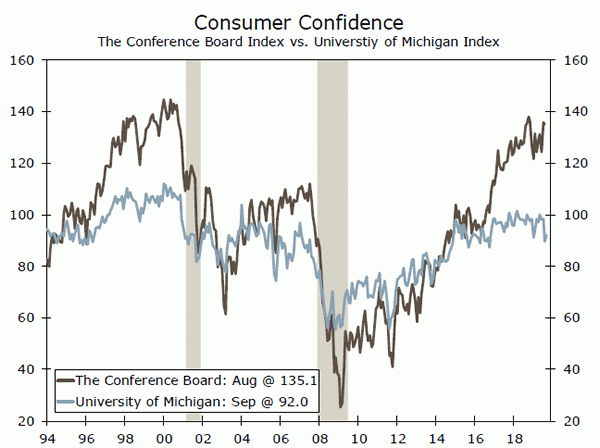
Personal Spending • Friday
Despite the split verdict on how consumers are feeling, there are no doubts about what they are doing. If they are feeling worried, it doesn’t show. Real personal consumption expenditures came in at a 4.7% pace in the second quarter. The Commerce Department will revise the Q2 GDP figures on Thursday of next week and we would not drop our coffee if that report included revisions that put a 5- handle on the rate of consumer spending.
Also next week we get the second piece of the puzzle for second quarter consumer spending when the monthly report on personal income and spending for August is released on Friday. Given the strong finish to Q2, the annualized growth rate is coming in hot at 6% through July. We expect to see the pace of consumer spending growth moderate as the year progresses, but the wind is certainly at the backs of consumers heading into the final months of the year.
Previous: 0.6% Wells Fargo: 0.3% Consensus: 0.3%
Durable Goods • Friday
As Boeing works to get clearance for its 737 MAX family of aircraft back into service, the variability in orders for these big-ticket items continues to be the key variable in orders for durable goods. With just six aircraft ordered during August, a headline decline in durable goods orders is practically unavoidable; it’s just a question of how big a decline it will be.
A better proxy for business spending, particularly during stormy times in the aerospace sector, is the underlying capital goods orders that remain after backing out both aircraft and spending by the U.S. defense department. That series, which we call “core capital goods orders,” is our best indication of where cap ex is truly headed. The fact that the ISM new orders component slipped into negative territory in August certainly does not do much to lift hopes for a big increase in core capital goods orders, but we’ll find out for sure when this report hits the wire on Friday.
Previous: 2.0% Wells Fargo: -1.6% Consensus: -1.2%
Global Review
Central Banks in the Spotlight
- Central banks were the focus this week, starting with Japan. The Bank of Japan made no major changes to its monetary policy at its September meeting, even as a majority of central banks have shifted to easing monetary policy.
- Elsewhere, the Bank of England unanimously decided to keep policy rates on hold. In addition to holding rates steady, Bank of England policymakers highlighted how uncertainty surrounding Brexit could weigh on inflation expectations.
- Bucking the trend of easier monetary policy, Norway’s central bank caught markets off guard this week with its fourth interest rate increase within the last year.
Bank of Japan on Hold… For Now?
Central banks were the focus this week, starting with the Bank of Japan (BoJ). The BoJ made no major changes to its monetary policy at its September meeting, even as a majority of central banks have shifted to easing monetary policy. Although the BoJ opted to keep rates unchanged, it did signal that additional easing was a future possibility. Governor Kuroda stated in his press conference that he is more inclined to ease policy now than he previously was in July. In addition, Kuroda hinted at possible action at its next meeting on October 31, about a month after the sales tax hike which is scheduled for October 1. As we have previously noted, we do not expect further BoJ easing; however, if the likelihood of a no-deal Brexit increases, and Japanese retail sales plunge, then BoJ easing would become a more realistic prospect.
Bank of England Holds Steady
U.K. economic data had generally been resilient earlier this year, but showed some mild softening in the latest figures. U.K. headline inflation rose just 1.7% year-over-year, the lowest since the end of 2016 (middle chart). The weaker than expected figure was driven by a decrease in the prices of computer games, toys and hobbies, while clothing and footwear inflation slowed. Core CPI inflation slowed to 1.5% year-over-year, down from 1.9% in July. With Brexit hovering over the U.K. economy, the Bank of England looked through the short-term swings in CPI inflation and unanimously opted to hold rates steady at its September meeting. In addition to holding rates steady, the committee highlighted that inflation may continue to print weaker than expected if uncertainty surrounding Brexit persists.
The Norges Bank’s “Dovish Hike”
Norway’s central bank caught markets off guard this week with its fourth interest rate increase within the last year. The central bank lowered its longer-term projections for the policy rate, and now is signaling that it may not raise rates further over the forecast horizon (bottom chart). In its policy report, the board noted that weaker growth prospects and lower interest rates abroad, combined with slightly lower inflation and a somewhat “less tight” domestic labor market, have contributed to the downward revision in the policy path. Meanwhile, the central bank lowered its nearterm inflation forecasts, but raised its longer-term projections, such that underlying inflation is projected to remain close to the central bank’s 2% target across the forecast horizon. Mainland GDP growth was upwardly revised in 2019 to 2.7% from 2.6%. However, in the years ahead, growth is expected to slow somewhat.
The central bank has been raising interest rates in an attempt to cool its economy, while has benefitted from generally buoyant oil prices and withstood the global slowdown and uncertainty surrounding global trade tensions and Brexit. However, the board’s current assessment of the Norwegian economy suggests that the policy rate will most likely remain at its current level over the forecast horizon. As of now, we share the same view as the board and believe the Norges Bank will be on hold for the foreseeable future.
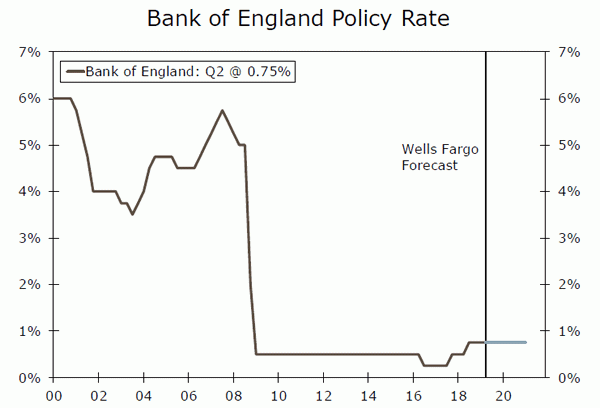
Global Outlook
Eurozone PMIs • Monday
Looking underneath the hood of the slowdown in the Eurozone economy shows a clear bifurcation in activity, with the services sector showing ongoing resilience despite a manufacturing sector that is essentially in recession. Indeed, as the chart at right shows, the Eurozone services PMI has actually moved higher even as the manufacturing PMI has generally moved in the opposite direction and remains well below 50.
The path of these PMIs will be crucially important for the fate of the Eurozone economy going forward. It seems unlikely that the current divergence can be sustained, and instead we would expect either the services PMI to collapse in line with the manufacturing index or for the manufacturing index to snap higher. For now, we lean toward the latter, as we generally have a constructive outlook for the Eurozone economy as a whole. That said, any signs of slippage in the services PMI would increase our concerns around the broader outlook.
Previous: 47.0 (Manufacturing), 53.5 (Services) Consensus: 47.3 (Manufacturing), 53.2 (Services)
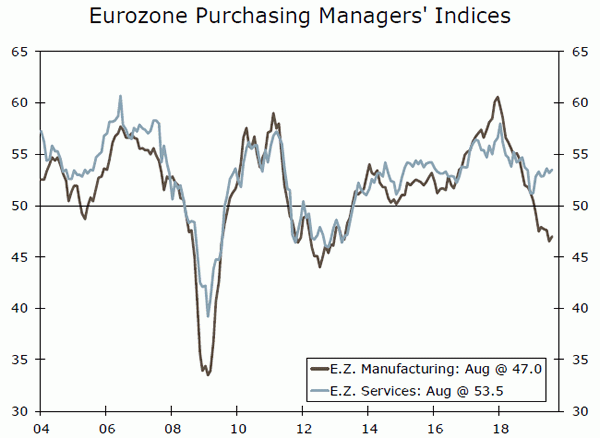
Reserve Bank of NZ Decision • Wednesday
The Reserve Bank of New Zealand (RBNZ) caught markets and economists off guard at its last meeting with a 50 bps rate cut, as most were expecting only a 25 bps cut. The central bank’s accompanying guidance was dovish too, as RBNZ Governor Orr said it was “easily within the realms of possibility” that the central bank could employ negative interest rates. The RBNZ’s current Official Cash Rate of 1.00% is not too far from zero, but the guidance nevertheless sent a strong dovish signal.
Most analysts expect the RBNZ to hold rates steady at 1.00% next week, but markets are pricing in further easing from the RBNZ in the coming months. In that regard, even if the central bank opts to leave rates on hold next week, it will be important to watch whether it signals further rate cuts ahead.
Previous: 1.00% Consensus: 1.00%
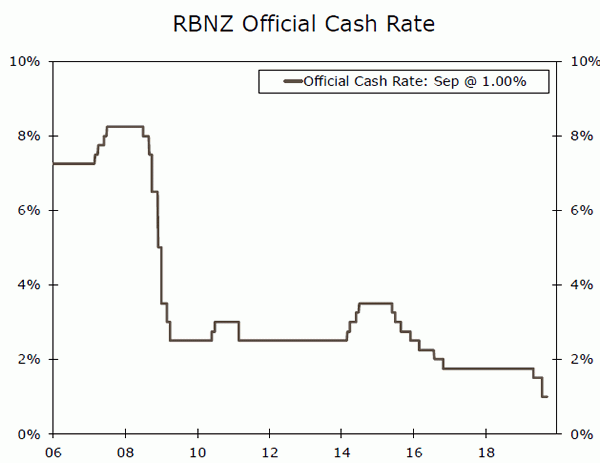
Banxico Policy Decision • Thursday
Mexico’s central bank finally delivered a long-awaited rate cut at its last meeting in August, reducing interest rates 25 bps to 8.00%. It was the first cut from Mexico’s central bank since 2014, and comes amid an ongoing slowdown in Mexico’s real economy, which is increasingly difficult to square with the central bank’s tight policy stance (our estimate of the real policy rate is roughly 4%, right chart). With economic growth continuing to slow and inflation relatively benign, Mexico’s central bank is likely to cut rates further, including a 25 bps cut expected by most analysts at next week’s meeting. Also supporting the case for more easing from Mexico’s central bank is the increasingly broad-based trend of global monetary easing from major central banks around the world, including the Federal Reserve. Lower global rates arguably offer scope for Mexico’s central bank to ease as the potential for domestic currency depreciation is somewhat lesser.
Previous: 8.00% Consensus: 7.75%
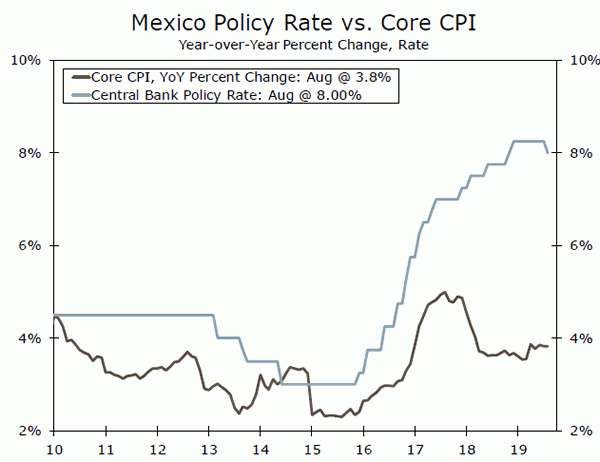
Point of View
Interest Rate Watch
Has the Fed Lost “Control”?
The FOMC held a policy meeting this week and, as widely expected, the committee reduced its target range for the fed funds rate 25 bps. As we note in a report that we wrote after the conclusion of the meeting, we look for the FOMC to cut rates an additional 50 bps between now and early next year (top chart).
The other notable development this week was the spike in money market rates. Indeed, the effective fed funds rate traded above the top end of the Fed’s target range on Tuesday (middle chart). As we wrote in a report this week, there are a number of reasons behind this week’s spike in money market rates. But the bottom line is that the Fed may be starting to lose its ability to control short-term interest rates.
So the question is what does the Fed do now? The underlying problem seems to be that there may be times when the banking system does not have enough reserves held at the Fed. Some commentators have suggested that the Fed will respond to this problem by pumping the banking system full of reserves again via a quantitative easing (QE)-style program of balance sheet expansion. But we do not believe that the Fed will return to QE at this time to solve this problem. For starters, a return to QE could send a confusing signal. Some market participants could infer that monetary policy is turning more accommodative than the FOMC actually intends. We do think that the Fed will end the decline in the excess reserves that the banking system holds at the central bank, and that the Fed’s balance sheet will begin to expand at a gradual pace again (bottom chart). But this is not the same thing as a return to QE.
If, as we believe, this week’s spike in shortterm interest rates was largely “technical” in nature, then the Fed has tools available to address the issue. For example, the Fed conducted four repurchase (repo) operations this week that added liquidity to the banking system. It potentially could make this repo facility “permanent.” In short, any dislocations that occur in money markets in the near term should be temporary. We plan to discuss these issues further in forthcoming reports.
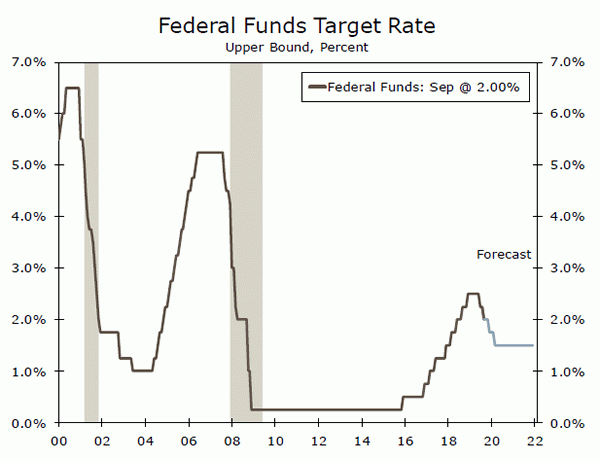
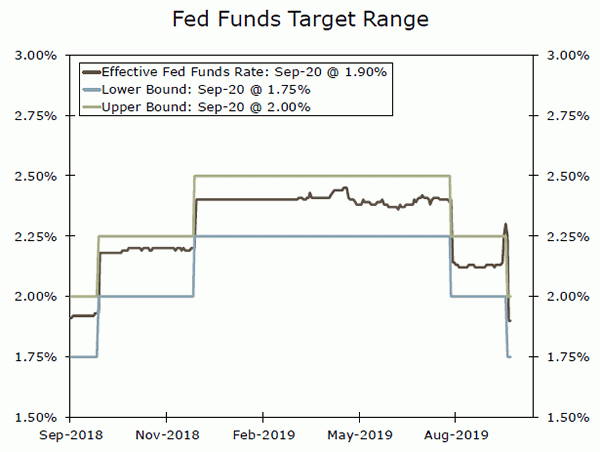
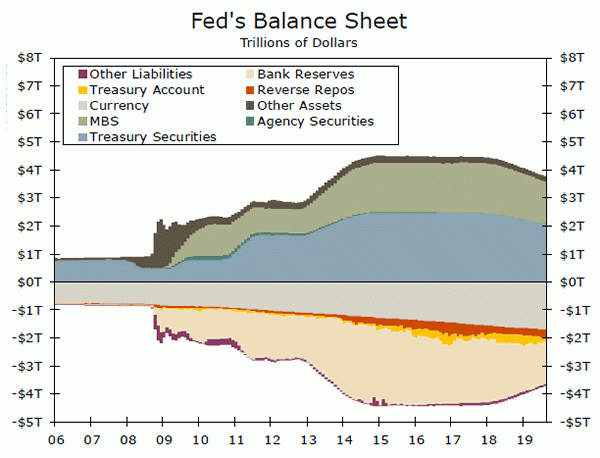
Credit Market Insights
No Man Left Behind
In 2018, for the first time in 12 years, the national poverty rate fell below its prerecession trough. At 11.8%, the poverty rate fell 0.5% and is down for the fourth consecutive year, according to the latest Income and Poverty Report from the U.S. Department of Commerce.
Somewhat tempering this development, was the poverty rate for lower-skilled workers, or those 25 and older without a high school diploma. The poverty rate for this group rose 1.4 percentage points to 25.9% and was the only group to see an increase. While the job market is tight by most measures, this group is typically the last to find work. Job openings have receded from their all-time high, but remain elevated, highlighting high demand for labor. As the economy continues to expand, this group should be pulled back into the labor market.
Data show lower-skilled workers who have found work are seeing a pick-up in wages. Average hourly earnings for the lowest paying industries (bottom 40%) were up 4.2% in July on a year-ago basis. That’s compared to a 2.2% gain for the highest paying industries. In fact, wage growth for the lowest paying industries has been outpacing the highest paying since 2014. The Fed is likely taking note. In Chairman Powell’s press conference this week he said, “…many who struggled to find work are now getting opportunities…This underscores for us the importance of sustaining the expansion so that the strong job market reaches more of those left behind.”
Topic of the Week
Oil + Tariffs: Eroding Consumer Spending Power
Attacks on Saudi Arabian production facilities last Saturday have brought oil prices back into the spotlight. The attacks are estimated to have knocked out 5.7 million barrels-a-day of production, or about 5% of global supply. While a meaningful share of the market, the outages caused by Saturday’s attacks are small when compared to the oil shocks of the 1970s. At the time of the 1973-74 embargo, OPEC accounted for about half of global output.
Currently, the impact to inflation looks set to be fairly small. Prices remain within their recent range and are up only about 5% since last week as officials estimate production can fully resume within a few weeks. Based on our CPI model, the move would add less than a tenth to the year-over-year rate of inflation. Moreover, that bump would prove temporary as prices ease again after production comes back on line, all else equal.
But of course, things are rarely ever equal. This past weekend’s event brings geopolitical risks for oil prices back to the forefront and raises the potential for prices to stay elevated even as production returns to normal.
If prices remain elevated for an extended period of time, either due to production taking longer to come back on line or the perception of risks around supply going forward, U.S. production could strengthen further. The impact to other segments of the U.S. economy, however, are less positive. While the effect on inflation looks rather small at present, it comes at a thorny time for manufacturers and consumers. Manufacturers reliant on inputs from China have borne the early brunt of the trade war and are already facing higher production costs at the same time sales are slowing.
There is increasingly less scope for companies to absorb tariffs as rates climb well into double-digits and consumer goods are increasingly exposed. While the inflationary effects of tariffs and higher oil prices are not massive at the moment, together they are set to erode real spending power and create a hurdle for consumers to carry growth at a time when capex spending is struggling.
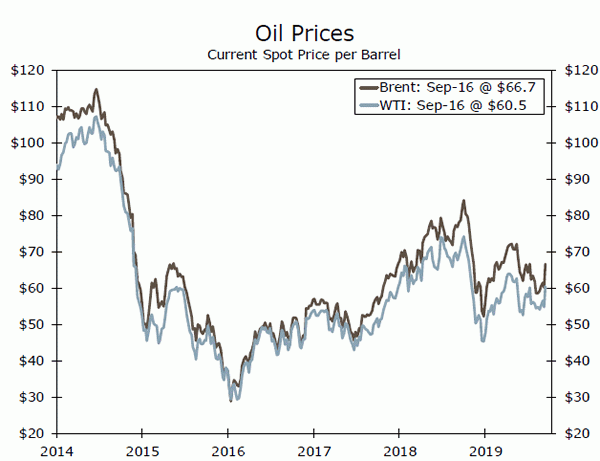
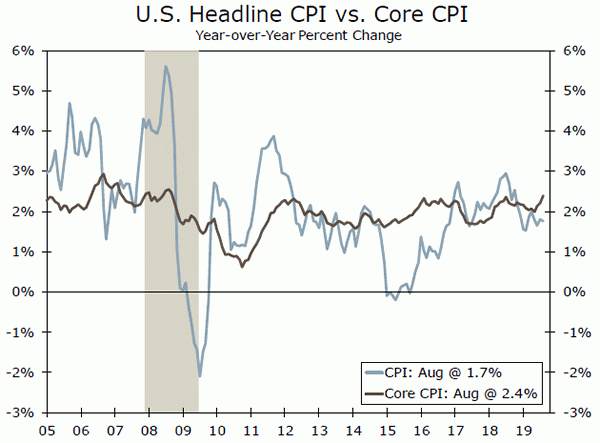

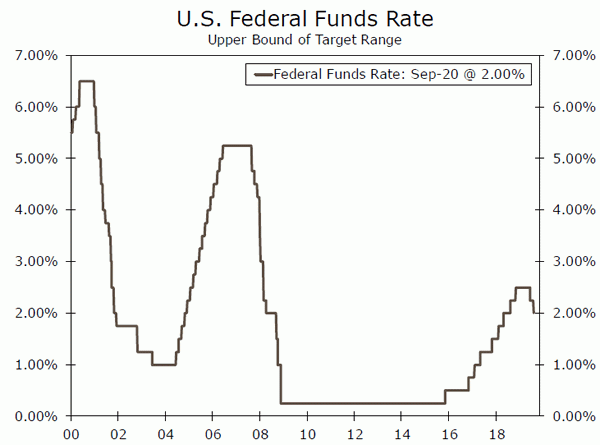
 Signal2forex.com - Best Forex robots and signals
Signal2forex.com - Best Forex robots and signals




